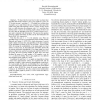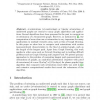47 search results - page 6 / 10 » How to draw the minimum cuts of a planar graph |
FOCS
2009
IEEE
14 years 3 months ago
2009
IEEE
— We show that for every fixed k, there is a linear time algorithm that decides whether or not a given graph has a vertex set X of order at most k such that G − X is planar (w...
DAM
2011
13 years 3 months ago
2011
Given a planar graph G, we consider drawings of G in the plane where edges are represented by straight line segments (which possibly intersect). Such a drawing is specified by an ...
DCG
2008
13 years 8 months ago
2008
The crossing number of a graph is the minimum number of edge intersections in a plane drawing of a graph, where each intersection is counted separately. If instead we count the nu...
GD
2006
Springer
14 years 6 days ago
2006
Springer
The planarization method has proven to be successful in graph drawing. The output, a combinatorial planar embedding of the so-called planarized graph, can be combined with state-o...
GD
2006
Springer
14 years 6 days ago
2006
Springer
st-orientations (st-numberings) or bipolar orientations of undirected graphs are central to many graph algorithms and applications. Several algorithms have been proposed in the pas...


